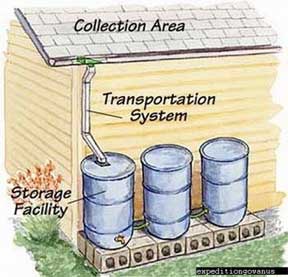|
| |
Benefits of rainwater
harvesting in homes
Main
Article page |
Beauty articles
|
Health page |
Computers|
Diseases |
Education |
Entertainment |
Family
Business |Fitness|
Fruits and Vegetables
|
Jobs |
General |
Personality|
Technology
|
Tourism |
Sports
House Plans |
House Loans |
Real Estate|
Vaasthu
Shastra|
Construction Tips
Engineering page
| Interior Design |
Property Buying Tips |
Renting Tips |
Journals /
Magazines
Education | List of Colleges |
Entrance

Rainwater Harvesting (RWH) is the process of
collecting and storing rainwater in a scientific and controlled manner for
future use. Rain water harvesting
systems are simple to install and operate.
Rainwater Harvesting in urban areas include
-
Roof top rainwater harvesting
-
Rainwater harvesting in paved
and un-paved areas (open fields, parks, pavement landscapes etc.)
-
Rainwater Harvesting in large
areas with open ponds, lakes, tanks etc.
Water is so precious that if and another third
World War is to be occurred, then that will be the war of Water. It is
life. Man can live without food for more than one month but without water man
cannot live more than seven days
In some cases, rainwater may be the only
available or economical water source. Rain water harvesting systems can be
simple to construct from inexpensive local materials, and are potentially
successful in most habitable locations. Roof rainwater can't be of good quality
and may require treatment before consumption. As rainwater rushes from roof, it
may carry pollutants in it such as the tiniest bit of mercury from coal burning
and bird feces.
Although some rooftop materials may produce
rainwater that is harmful to human health, it can be useful in flushing toilets,
washing clothes, watering the garden and washing cars; these uses alone halve
the amount of water used by a typical home.
Components of Rain Water Harvesting
Rain water collection may be from roof tops,
terrace, courtyard, paved or unpaved open ground etc. But Roof water harvesting
system which is the simplest and easiest will be the most suitable method . It
has the components like Catchment area, Collecting Gutters, Transportation,
First flush, Filter and Storage tank.
Down pipe and first flush
arrangement
This is an arrangement to prevent the dust and other unwanted materials that may
be seen on the roof, from reaching the storage tank. By fitting a down pipe with
an end cap or valve can ensure that the washed water from the roof does not
reach the storage tank. It is always safe to ensure that the first flush
arrangement remains open during non- rainy days and should be closed after first
rain up to the satisfaction of the end user.
Filter unit
The rainwater collected from the roof should be allowed to reach the storage
tank only through a filtering mechanism. Rubble, sand and charcoal, as used in
the traditional three-pot filtration, can be adopted here. 10 cm thick 20mm
rubbles, 10 cm thick charcoal/coconut shell, 15 cm thick coarse sand, 5 cm thick
6mm rubbles etc. may be arranged from bottom to top in the filter unit. The
water that is passed through this filter should remain safe for a long period of
storage. Charcoal/coconut shell is added to eliminate gaseous pollutants.
Storage tank
Mainly three types of storage tanks are constructed for roof water harvesting.
They are above ground, underground or sub surface tanks as per requirement. The
storage tank may simply be the collection drums.
Provision for drawing water and spill over
For drawing water from the storage tanks, any method may be adopted provided it
shall be drawn only when needed. The easier the method adopted for drawing
water, the more will be the chances for its misuse. The adopted methods may be a
tap, hand pump or electric pump sets.
Maintenance
- Before collecting the rain water, the roof,
gutters and tank should be cleaned
- Let the first 2-3 rains flow out through
the first flush system
- Remember to clean the tank once in a year
- Replace the filtering agents every year
- Keep the tank and surroundings clean and
hygienic
- Apply white cement on the tank every year
- Remember to preserve water and use it
judiciously
Advantages of Rain Water Harvesting
Rainwater harvesting systems are simple to install, operate, and maintain. It is
convenient in the sense that it provides water at the point of consumption and
operating costs are negligible. Water collected from the roof catchment is
available for use in potable and non-potable applications such as toilet and/or
urinal flushing, laundries, mechanical systems, custodial uses, site irrigation
and for bathing water. Since rainwater is collected using existing structures,
i.e., the roof, rainwater harvesting has few negative environmental impacts.
Benefits of Using Rain Water Harvesting
Rainwater is free; the only cost is for collection and use. It lessens demand on
the municipal water supply. It saves money on utility bills. It makes efficient
use of a valuable resource. It diminishes flooding, erosion, and the flow to
storm water drains. It reduces the contamination of surface water with
sediments, fertilizers and pesticides from rainwater run-off resulting in
cleaner lakes, rivers, oceans and other receivers of storm water.
It can be used to recharge ground water. It is good for irrigation and plants
thrive because stored rain water is free from pollutants as well as salts,
minerals, and other natural and man-made contaminants. It is good for laundry
use as rain water is soft and lowers the need for detergents. It adds life to
equipment dependent on water to operate, as rain water does not produce
corrosion or scale like hard water. It can help achieve LEED Green Building
Rating Credit.
What are the benefits of rain water collection?
Rain water is the purest form of water. In rain water, we have total control
over our water supply. It is very ideal for cities with water restrictions. It
is socially acceptable and environmentally responsible. It promotes
self-sufficiency and helps conserve water. Rain water is better for landscape
plants and gardens because it is not chlorinated. It reduces storm water runoff
from homes and businesses. It can solve the drainage problems on your property
while providing you with free water.
It uses simple technologies that are inexpensive and easy to maintain. The
potential cost savings especially with rising water costs. It can be used as a
main source of water or as a backup source to wells and municipal water. The
system can be easily retrofitted to an existing structure or built during new
home construction. Systems are very flexible and can be modular in nature,
allowing expansion, reconfiguration, or relocation, if necessary. It can provide
an excellent back-up source of water for emergencies.
For a poor family to construct high quality storage tank may not be possible,
therefore the best method will be construction of katcha ponds lining with
tarpaulin. Collection of Rain water in the drums is also another feasible way.
If the Harvesting is to be done for the whole village, then a bigger ferro-cement
tank with roof may be constructed.
Therefore, we should not leave the advantages of Rain water harvesting. A GCI
roofing house having a surface area of 30 ft. X 40 ft. can collect about
1,49,500 litres of water per annum while the average rainfall is calculated at
1790 mm and efficiency for 75%.
Rain water harvesting will particularly benefited the hill dwellers as the water
problem is more acute for them. The Municipal councils, Small town committees
and Panchayats also should have their own Rain water harvesting facilities to
help the public supply, to improve the ground water condition and for more
greenery.
( Reference: Article by
Mr.N Munal Meitei, Range Forest Officer wrote for The Sangai Express. ,
http://e-pao.net/ )
More..
Articles:
-
Tips & guidelines: Electricity Saving at home
-
Coming Up With Landscaping Ideas
-
How to set out a building on site
-
What
is
Green Building ?
-
What is Domestic biogas plant ?
-
Why home insurance is very important in India?
-
How To Install a Home Wind Turbine
to get energy
-
How to Install Electric Wiring
-
Significance of Home Plumbing
-
Should I buy or rent? A simple calculation
-
Easy Landscaping Tips for Beginners
-
Construction technique:
Rapidwall technology
-
Buying a flat? Don't get carried away by the sample
-
30-storey hotel built in just 15
days
-
Is it worth buying an old
house
-
House plans, home plans, plans, residential plans
-
House Loans, home loans, where to get housing loan
-
How do loans work, the basic concepts of loans
-
Construction Tips, construction guide lines,
-
house rental tips, rental tips, renting properties
-
Real Estate
-
Flooring
-
What is Reverse Mortgage
-
Guidelines to purchase residential properties
-
Lotus-shaped 91 feet prayer hall in kerala
-
What is Interior Design, interior desings, resources
-
Interior Design Colleges
-
Interior Design- Bed Rooms
-
Interior Design- Bath Rooms
-
Kitchen Designs, kitchens
-
Modern Architectural Design Softwares
-
Landscaping Designs landscape architectures
-
-
|
|
| |
|



